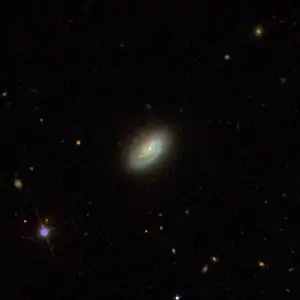NGC 5372
NGC 5372 ist eine 13,0 mag helle spiralförmige H-II-Galaxie vom Hubble-Typ S? im Sternbild Großer Bär und etwa 82 Millionen Lichtjahre von der Milchstraße entfernt.
| Galaxie NGC 5372 | |
|---|---|
 | |
| SDSS-Aufnahme | |
| AladinLite | |
| Sternbild | Großer Bär |
| Position Äquinoktium: J2000.0, Epoche: J2000.0 | |
| Rektaszension | 13h 54m 46,0s[1] |
| Deklination | +58° 40′ 01″[1] |
| Erscheinungsbild | |
| Morphologischer Typ | S? / HII[1] |
| Helligkeit (visuell) | 13,0 mag[2] |
| Helligkeit (B-Band) | 13,9 mag[2] |
| Winkelausdehnung | 0,6′ × 0,4′[2] |
| Positionswinkel | 140°[2] |
| Flächenhelligkeit | 11,3 mag/arcmin²[2] |
| Physikalische Daten | |
| Zugehörigkeit | LGG 360[1] |
| Rotverschiebung | 0.005727 ±0.000043[1] |
| Radialgeschwindigkeit | 1717 ±13 km/s[1] |
| Hubbledistanz vrad / H0 |
(82 ± 6) · 106 Lj (25,2 ± 1,8) Mpc [1] |
| Geschichte | |
| Entdeckung | Wilhelm Herschel |
| Entdeckungsdatum | 24. April 1789 |
| Katalogbezeichnungen | |
| NGC 5372 • UGC 8843 • PGC 49451 • CGCG 295-024 • MCG +10-20-46 • IRAS 13530+5854 • GC 3711 • H III 809 • h 1709 • LDCE 1005 NED005 | |
Sie wurde am 24. April 1789 von Wilhelm Herschel mit einem 18,7-Zoll-Spiegelteleskop entdeckt, der sie dabei mit „vF, vS“[3] beschrieb.[4]
Weblinks
Einzelnachweise
- NASA/IPAC EXTRAGALACTIC DATABASE
- SEDS: NGC 5372
- Auke Slotegraaf: NGC 5372. Deep Sky Observer's Companion, abgerufen am 14. Februar 2016 (englisch).
- Seligman
This article is issued from Wikipedia. The text is licensed under Creative Commons - Attribution - Sharealike. The authors of the article are listed here. Additional terms may apply for the media files, click on images to show image meta data.
